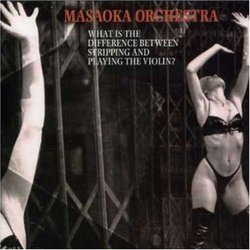| All Artists: Masaoka Orchestra Title: What Is the Difference Members Wishing: 1 Total Copies: 0 Label: Victo Release Date: 7/7/1998 Album Type: Live Genres: Jazz, Pop Style: Number of Discs: 1 SwapaCD Credits: 1 UPC: 777405005823 |
Search - Masaoka Orchestra :: What Is the Difference
CD Details |
CD ReviewsCreative Orchestral Music and the Politics of Time and Place greg taylor | Portland, Oregon United States | 08/12/2004 (4 out of 5 stars) "Don't worry about the title. I won't get too learned on ya if just want to know about the music.
I just wanted to point out that some musical events have a specific historical location. We can appreciate the music on its own but we will do so more if we have an inkling of that historical location. Both the pieces on this CD have that sort of historical specificity. The first piece's title refers to the half-life of plutonium. In Masaoka's notes, she relates that she started thinking about this upon her first trip to visit relatives in Japan when she found out that a cousin of her father's had died of leukemia caused by the bombing of Hiroshima. That, combined with concerns about the fact that there are hundreds of tons of plutonium in the US and Russia, led her to the writing of this piece. This is a live recording of a public performance of this piece. The second piece has a much great historical specificity. It was written in response to the violent killings of five prostitutes in Masaoka neighborhood in the Mission District of San Francisco. She felt that the public outrage and police response was greatly muted due to the fact that the victims lived outside our ideas of good behavior for women. Thus the title of the piece and the CD. This performance was also recorded live on Market Square. If you heard this music and then read about its history, I think you would be surprised. The music is not about anger or recrimination. The feeling to me seems to be much more about what we are missing out on by our closed mindedness, about the possibilities of a culture that is truely open. Masaoka (who is a great great koto player) has created a personal hybrid that incorporates a classical understanding of string instruments, an appreciation of soul jazz, and a deep knowledge of the music of Asian cultures. This is a woman who has released a trio recording of Monk tunes with the lead voice being that of the koto. This isn't a person who is trying to mix her influences into something new- she did that so long ago that she now she is just a unique voice. The instrumentation on these pieces along with the players goes a long way to give you some idea of how wonderful they are. Since these pieces require a fairly large orchestra and since there is only about fifty percent overlap of the personnel, I am going to limit myself to the personnel for What Is The Difference Between Stripping And Playing the Violin? We start with great, the inestimable India Cooke on violin along with Carla Kilstedt on violin, Vijay Iyer on piano and violin (who knew?) and Mark Izu on the contrabass and sheng (think a complicated and nasal mouth organ). The string section is completed by Liu Qi-Chao on the erhu (think two-stringed violin) and Elliot Kavee on the cello. Liberty Ellman plays the guitar, Trevor Dunn plays electric bass and Anthony Brown is the drummer. Francis Wong plays tenor sax and the underappreciated Hafez Modirzadeh plays tenor and soprano sax as well as piccolo and the ney (persian flute). Toyoji Tomita adds a nice trombone sound to the horn mix. Then there is the contributions on Thomas Day, Patty Liu, Robbie Kauker and DJ Mariko on various electronics. You can see the possibilities. There are string sections informed by modern classical music, a couple of very nice soul-jazz sections that evolve into brief pungent solos by Tomita and later by Ellman, a wonderful erhu solo, a later solo by the ney or maybe the sheng (I am no expert by any means) and so on. It is episodic, purposely so, to express the nature of street life in the Mission district but it is also wonderfully of a piece and very engaging. This is a great work and one that deserves to be better known. One of the sad truths of the contemporary arts is that there are a lot more composers and players than there is money to fund their projects. Even when they are successfully funded and recorded they tend to disappear in the great din that is the contemporary music scene. This is an artist that is worth keeping an ear on. You may not be as please as I am with her orchestral music but by all means check out her other CDs. Besides the trio of Monk recordings, I also highly recommend a Larry Ochs CD released this year on the Intakt label called Fly, Fly, Fly. It features Ochs in trio with Masaoka and Joan Jeanrenaud on the cello. As good a CD as has come out this year. " |

